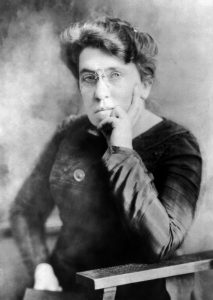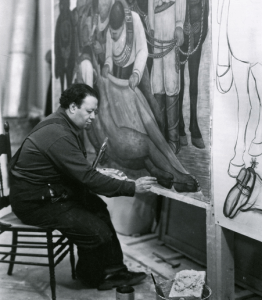Many people know of the Mexican holiday Día de Los Muertos, which is filled with vibrant colors and intricately painted faces. What many people don’t know is that this holiday originated over 3000 years ago with the Aztec empire. The Spanish Conquistadors first recorded a Día de Los Muertos celebration during the 16th century. When the Aztecs had begun this tradition, they weren’t remembering loved ones who passed, but they were worshiping the queen of the underworld and protector of the dead.1

This Aztec queen was Mictecacihuatl, “Lady of the Dead,” Queen of Mictlan.2 According to Aztec legend, Mictecacihuatl was sacrificed as an infant and placed in the underworld to become the wife of Miclantecuhtl, the king of the underworld. In the underworld, her role was to watch over the bones of past lives, which would be used to create new life in the living world. However, in order for the bones to be able to create new life, they needed to be stolen from Mictecacihuatl to be brought to the living world. As their protector, part of her own life would be carried with the stolen bones. Even after the bones were stolen, she would continue her duty to protect them by returning to the living world every year to make sure the bones were being properly taken care of. When the time came for her to return to the living world, the Aztecs celebrated Mictecacihuatl’s return with death festivals and traditional dances, to honor her for her protection of the bones that created life and to seek protection for those who died.3

The Aztecs celebrated Día de Los Muertos much differently than it is celebrated today due to the Spanish conquistadors and Catholicism. The Spanish changed the lives of the indigenous peoples wherever they went, from taking land for the Spanish throne to converting people to Catholicism. Many traditions changed, including those of Día de Los Muertos.4 The Aztecs laid out offerings for the King and Queen of the Underworld for the whole month of August, and the Spanish were the first outsiders to witness this honoring of Mictecacihuatl by the Aztecs. Not long after the Spanish exposure to this festival, the Spanish combined the Aztec tradition with Catholicism. Syncretism, the blending of Spanish and indigenous beliefs and practices, combined the Aztec traditions of Día de Los Muertos with the Spanish traditions of All Saint’s Day and All Souls Day.5 Some examples of syncretism between Catholicism and Día de Los Muertos are the symbols that are most recognizable with Día de Muertos, such as decorated skulls and skeletons, and the Spanish character “La Catrina,” who represents Mictecacihuatl.6 The merging of Catholicism with the Aztec religious beliefs began the evolution of how Día de Los Muertos, transforming how it is celebrated today.

Despite that the name Día de Los Muertos translates to Day of the Dead in English, the holiday is actually the celebration of life. Día de Los Muertos doesn’t focus on death and mourning of a loved one. It’s seen as a happy celebration where family members of all generations, deceased and alive, can be together as one. The traditions of this holiday have changed from honoring the queen of the underworld Mictecacihuatl to honoring those who have passed.7 It’s a time of colorful festivals and parades, beautifully painted colorful skulls, marigold flowers, decorated ofrendas, grave site visits and the smells of traditional Mexican foods and incense in the air. Although it is primarily celebrated in Mexico, some parts of the United States, especially cities and towns on the Mexican border, have adopted the tradition and celebrate the remembrance of their deceased loved ones.
- MasterFILE Complete, 2008, s.v. “Día de los Muertos, by Benjamin Perea. ↵
- Sin Jones, Mictecacihuatl, Santa Muerte, 2010, 1-16. ↵
- Sin Jones, Mictecacihuatl, Santa Muerte, 2010, 1-16. ↵
- Mark Lacy, Origins of El Día de Los Muertos: The Prehispanic Festival of the Dead Defies Cultural Invasions of Mexico, (History Institute for Culture), 1. ↵
- Mark Lacy, Origins of El Día de Los Muertos: The Prehispanic Festival of the Dead Defies Cultural Invasions of Mexico, (History Institute for Culture), 1. ↵
- Mark Lacy, Origins of El Día de Los Muertos: The Prehispanic Festival of the Dead Defies Cultural Invasions of Mexico, (History Institute for Culture), 1. ↵
- Christina Zarate, Día de Los Muertos, (Smithsonian National Museum of American History), 2-7. ↵



114 comments
Hector Membreno
I had heard of Día de Los Muertos but I had never read about it or received this much information about this day in the Mexican culture. One thing that I learned that I did not know before was that this day was a holiday I knew it was significant day but I did not know that this was a legitament holiday. I love learning about different cultural events such this one which this article did a great job of expressing.
Edith Santos Sevilla
I really liked the article and how El Dia de los Muertos changed when the spanish conquered. Since I was young I was always used to celebrating el Dia de los Muertos, but I never really asked myself how it originated. I knew the story of the queen of the underworld, but I never really made the connections. This article describes the necessary information to understand the story and how Catholicism and the Aztec tradition combined to make what people celebrate today. It is such a different celebration of what people do today, compared to what was done during the Aztecs. It just shows how culture is change throughout time and because of different ideas.
Jake Mares
I have always been intrigued in the Day of the Dead and the traditions within it. It is cool to see an ancient way of celebrating the famed holiday with offerings to the Underworld Queen during a whole month and then how that is passed on with the Spanish invasions. This blend of culture is something we can still notice today and is coming soon.
Amelia Hew
I was always fascinated with the celebration of the day of the dead. Many movies or animations portraited this celebration and I was captivated by the beautiful decorations. I always thought that the day of the dead was to remember those who had passed, but I never knew it was once used to worship an underworld goddess, which deepens my knowledge of Mexican culture. I love how the article explains this unique celebration in a detailed but simple way.
Vania Gonzalez
Dia de Los Muertos is very misinterpreted now a days until recently I had no idea that the actual celebration was originally for life and not death. This article just put the backstory to what I had found out a few months ago and with the day of the dead almost a month away it is very important to know the origins of the actual tradition that was started. And also I think that catholicism really affected every tradition of the Aztecs and altered a lot of the celebrations and meanings behind the culture.
Malleigh Ebel
I thought it was interesting they sacrificed Mictecacihuatl as an infant instead of a virgin teen to be the bride of Miclantecuhtl. Mictecacihuatl’s job of protecting the dead bones to become living again facinates me: especially the fact that she is so calm and collected as to simply check on them in the living world to keep tabs on them. I have never heard the origin story of Dios de los Muertos, however I really enjoyed it.
Juan Arceo
As a little kid, my perspective was the same way as it was for most Mexican-Americans in this nation. You remember your loved ones, on either all saints day or all souls day, you create an altar, you fill it up with ofrendas, and you remember all the good times that you had with this person. This article however really changed my view on how it was originally celebrated due to Mictecacihuatl, the lady of the dead, as the Aztecs worshipped her for being able to protect the dead and protect those who lived thanks to the bones that she would get.
Kelsey Sanchez
I really enjoyed reading this article because as I grew up, I always knew that for this day we celebrate and honor those who have passed away. Growing up in a Hispanic household, I never realized how the this all started and how the Spanish combined the Aztec tradition with Catholicism. As this celebration continues to go on today in society, I feel it is very beautiful and nice to be apart of it because it lets you remember that there’s always going to be a special day just dedicated for those who have passed away. This day can also serve as a reflection as well because it expresses how family and friends should continue to be there for one and other because even if they are not here, we still can always have them in our memories.
Sierra Salas
I was enlightened after learning about the origin story of Dia de Los Muertos. Growing up hispanic, I knew about Dia de Los Muertos as a celebration of the life of a loved one who had passed. Before this article, I had no idea that originally it was a time to honor Mictecacihuatl, the queen of the underworld. Reading this article was a way for me to discover information about how my ancestors celebrated Dia de Los Muertos before the Spaniards and Catholicism changed the celebration. This article is one I would recommend to my friends, so they too can learn about the history of Dia de Los Muertos and the changes it has encountered.
Carlos Tami
I have always heard of this day but never got a true historical background. Taking Spanish classes in earlier years of school we were taught how it was celebrated but never truly why it was. You definitely gave me an answer to that question, the insight as to it is a day when all generations can be together as one is eye opening. I’ve never been able to experience it first hand so my only impression is the way its seen in movies. Living in San Antonio all my life I’ve been friends with many Mexicans but I haven’t necessarily seen them celebrate as extravagantly as typically depicted.